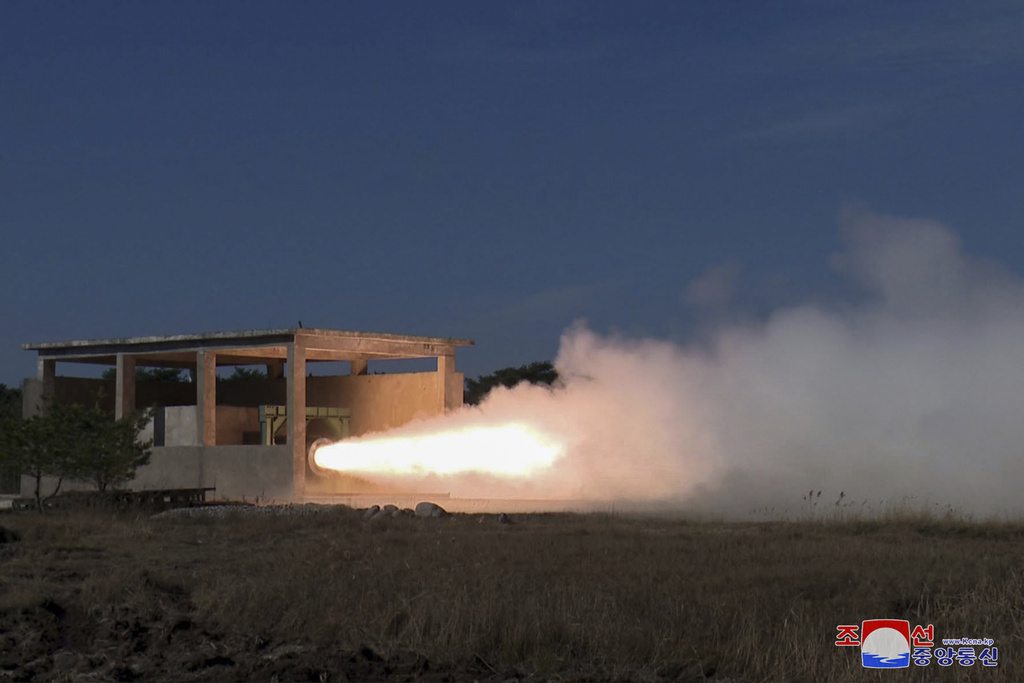North Korea said Wednesday it successfully tested new solid-fuel engines designed for intermediate-range ballistic missiles as it continues to work on developing nuclear-capable weapons targeting its rivals in the region.
North Korea’s official Korean Central News Agency said the country’s military scientists tested the first-stage and second-stage missile engines on Saturday and Tuesday. The report did not say when the new missile system was expected to be completed.
The North’s existing intermediate-range missiles, including the Hwasong-12 that may be able to reach the U.S. Pacific territory of Guam, are powered by liquid-fuel engines, which need to be fueled before launch and cannot stay fueled for long periods of time.
Missiles with built-in solid propellants can be made ready to launch faster and are easier to move and conceal, which theoretically makes it harder for adversaries to detect and preempt the launch in advance.
The recent tests were an “essential process for further enhancing the strategic offensive capabilities of (North Korea’s) armed forces in the light of the grave and unstable security environment facing the country and the future military situation in the region, in which the enemies will get more vicious in their military collusion and nexus,” KCNA said.
Tensions on the Korean Peninsula are at their highest point in years after North Korean leader Kim Jong Un ramped up his weapons demonstrations, including events he described as simulated nuclear attacks on the South. He also authorized his military to launch preemptive nuclear strikes against enemies if it perceives Pyongyang’s top leadership to be under threat.
South Korea has responded by expanding its combined military exercises with the United States, which Kim has condemned as invasion rehearsals, and enhancing trilateral security cooperation with Japan. Seoul is also seeking stronger public assurances from Washington that it would swiftly and decisively use U.S. nuclear weapons to protect the South in case of a North Korean nuclear attack.
During their annual security talks this week, U.S. Defense Secretary Lloyd Austin and South Korean Defense Minister Shin Won-sik signed an updated a bilateral security agreement with the aim of more effectively countering North Korea’s evolving nuclear and missile threats.
Shin said the new document spells out that the United States would mobilize its full range of military capabilities, including nuclear, to defend the South in the event of a North Korean nuclear attack. He also said the document will be a template for the allies to strategize how South Korea could assist U.S. nuclear operations in such events with its conventional capabilities but didn’t elaborate further.
North Korea earlier this year revealed its first solid-fuel intercontinental ballistic missile, the Hwasong-18, which has the potential ability to reach deep into the U.S. mainland.
Analysts say the North has to clear further technological hurdles to have a viable nuclear arsenal that could threaten the United States.
All of North Korea’s ICBM tests so far were done at high angles to avoid the territory of neighbors, so it’s not yet clear whether the country has mastered the technology to ensure its warheads would survive atmospheric reentry well enough to precisely hit their targets.
North Korea’s claims that the engine tests were successful suggest the country will flight-test the new missile in coming weeks, said Cheong Seong-Chang, an analyst at the private Sejong Institute in South Korea. The missile could pose a potential threat to Guam, a major U.S. military hub, and to American military bases in Japan, which may add to Japan’s urgency to upgrade its military and further expand three-way security cooperation with Seoul and Washington, Cheong said.
The latest steps in North Korea’s weapons development follow concerns about a potential arms alignment with Russia, in which North Korea provides munitions for Russia’s war in Ukraine in exchange for Russian technology transfers that would upgrade Kim’s military nuclear program.
South Korean intelligence and military officials have said North Korea may have shipped more than a million artillery shells to Russia beginning in August, weeks before Kim met Russian President Vladimir Putin. Both Moscow and Pyongyang have denied U.S. and South Korean claims about the alleged arms transfers.
Separately, KCNA reported that Russia’s natural resources minister, Alexander Kozlov, is visiting North Korea in a sign of the countries’ expanding diplomacy. The report said the two sides were engaged in talks over trade, science and technology exchanges, but it did not elaborate further.
The Associated Press had reported he arrived in Pyongyang on Tuesday.
(AP)











